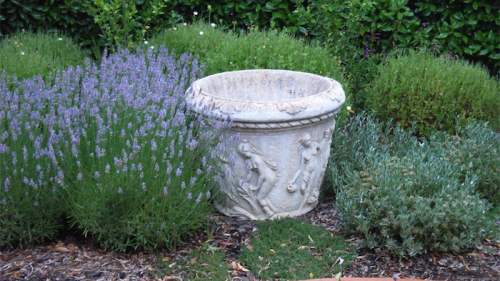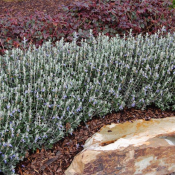
A combination of silver, purple and white shrubs… English lavenders growing in combination with Cistus “Gallipoli Rose”, pink carpet thyme and Convolvulus cneorum.
That’s the feedback I get from designing planting schemes and public talks.
Some gardeners still want to repeat Vita Sackville-West’s famous White Garden at Sissinghurst Castle in England.
I am often asked to design using a combination of white and blue flowers with contrasting grey foliage. Or grey foliage with yellow flowers seems also to be acceptable, as does lavender with its grey foliage and purple flowers.
I’m told that the last thing householders want to look at on summer days are the hot colours of red and orange.
So, here are a few suggestions for grey-foliage plants, some semi-prostrate and others more of a small shrub, but all suitable for the smaller garden:
- Artemisia “Powis Castle” (dwarf wormwood) grows to about 60cm high with a metre-wide spread.
- Lavenders, with the French lavenders the first to flower in early spring such as Lavandula “Perfume Princess”.
- Two of the most popular summer-flowering lavenders are the English lavenders, Lavandula “Hidcote”, growing to about a metre or the lower-growing more compact L. “Munstead”. If you want to make fragrant potpourri for lavender bags to discourage silver fish in drawers or to put under the pillow to help with a relaxing sleep, these two varieties are ideal. It is recommended to cut the English lavender just as the flowers start to open in early summer when the fragrance is at its best for drying, not in autumn when they have almost finished flowering.
- Stachys lanata commonly known as Lamb’s Ears with soft, light-grey foliage.
- Cistus “Sunset” or Rock Rose (not actually related to roses) with grey foliage and pink flowers, growing to 60cm x 60cm.
- Phlomis fruticosa or Jerusalem Sage has grey foliage contacting with its tall, strange-looking yellow flowers in clusters along the stems. It grows to 1m x 1m.
- Teucrium “Silver Box” is a new, grey-leafed plant with grey foliage and blue flowers. Growing to 60cm tall x 50cm wide, it is suitable for the smaller garden. I suspect this is going to become very popular for borders as an alternative low hedge to box hedging. Yes, there are many alternatives to Buxus sempervirens or box that can be clipped to shape with the advantage of flowers. Although some may be surprised to learn that box plants do have flowers, although so insignificant they are easily missed.
![Teucrium “Silver Box”.]()
Teucrium “Silver Box”.
- Let’s not forget some of our wattles in their low prostrate form, such as Acacia baileyana prostrate, are ideal for training over rocks or stone walls.
- Convolvulus cneorum with its silver-grey foliage and white flowers is a hardy Mediterranean plant growing to about 40-50cm and is also an ideal container plant.
Jottings…
- When the oak tree comes into leaf before the ash we are guaranteed a fine, mainly dry summer.
- Plant garlic and spring onions.
- For citrus growing in containers, remove a few centimetres of soil and add sieved compost.
- Leave the foliage of frost-affected plants to protect the soft, new growth underneath; we still have plenty of frosts to come.
- Dig Seamungus seaweed and chook poo certified organic fertiliser into the vegetable bed and turn over every couple of weeks before planting spring veggies.
The post Gardening / 50 shades of grey, sort of appeared first on Canberra CityNews.
